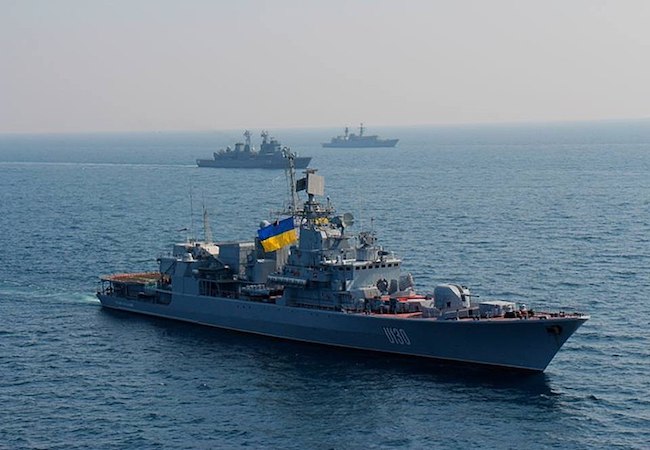New Ukrainian naval base is a NATO pressure point aimed against Russia
The construction of a Ukrainian naval base in the Azov Sea is an indirect attempt by the West to artificially create a new international problem and an area of military tension near the Russian borders. The Ukrainian navy is acting on behalf of the U.S. and NATO to escalate a problem on the unilateral militarization of the Azov Sea.

By Paul Antonopoulos
Ukrainian President Vladimir Zelenski last week visited the site for the new naval base in Berdiansk, saying “it is very important to have your own ships in this place. Indeed, in this way we will protect our ports and trade. This is direct aid to the economy.”
Construction of three new berths and dredging will begin immediately after the project is approved. The Berdiansk port administration has mentioned that the military base will neither affect work nor reduce the capacity of the commercial port.
Objectively, there are no military threats in the Azov Sea. Moscow and Kiev in 2003 concluded an agreement on the shared use of the Azov Sea, and in 2012, an additional agreement on measures to ensure the safety of navigation was added to the agreement. The construction of the Crimea Bridge has changed nothing fundamentally. The measures to protect the bridge are reasonable, sufficient and do not prevent civil and commercial transport on the Azov Sea and the Kerch Strait. The intrigue lies in the fact that the 2003 agreement prohibits the entry of foreign naval forces into the Sea of Azov, without the agreement of both sides – Russia and Ukraine.
Today, Ukraine has two naval bases – in the Odessa and Nikolaev regions. These deployments allow ships at any time to enter the Black Sea and onto the Mediterranean Sea, without being restricted by the narrow bridge over the Kerch Strait. To get under the Crimea Bridge, permission from Russia will be needed. The distance of the Kerch Strait between Crimea and Taman on the opposite side of the bridge is about 5 kilometers wide, and the navigation pass is 500 meters from the coast and is controlled directly by the Russia.
The transfer of one of the two Ukrainian naval bases to Berdiansk is an ambiguous project from the time of Ukrainian President Petro Poroshenko, and the continuity observed today in the military construction shows, first of all, the lack of independence in the strategic decisions taken by Kiev as it is likely NATO making this request. The inaccessibility of the Azov Sea area is a painful geopolitical challenge. For NATO, the Berdiansk port is an excellent location as the Ukrainian navy will be located only 70 kilometers from the Russian coast and 220 kilometers from Rostov-on-Don, where the headquarters of Russia’s Southern Military District is located.
Zelenski has not changed the old plans of the Maritime Fleet, and at the end of 2019, the division of Azov sea vessels based in Berdiansk and Mariupol was created. Zelenski has not yet acknowledged Russia’s sovereignty over Crimea and will not do this without Washington’s approval – meaning a new military conflict could be a possibility. In March, the Pentagon notified the U.S. Congress of its intention to provide assistance to the Ukrainian Armed Forces to the amount of $125 million.
It is inevitable that there will be an increase in Pentagon and NATO activity in the regions bordering Russia. The Russian Black Sea Fleet forces are in constant state of preparedness, especially since on April 13 the American rocket destroyer Porter entered the Black Sea. This destroyer and other U.S. and NATO warships will never be able to enter the Azov Sea as it effectively an inland sea of Russia and Ukraine where only commercial cargo vessels of these two countries can enjoy freedom of navigation.
The Kerch Strait has never been international according to the 1982 UN Convention, which means that the right of transit or peaceful passage for foreign ships cannot apply to it, as much as Washington wishes it did. The Russian Foreign Ministry has repeatedly stressed that all responsibility for a possible aggravation in the Azov region lies with the Ukrainian authorities and the countries that supports them. At the same time, Moscow is still ready for constructive dialogue, but the construction of a new naval base to serve against Russia shows that Kiev are not interested in such a solution.
Paul Antonopoulos is the Director of the Multipolarity Research Center and Managing Editor at Fort Russ News




